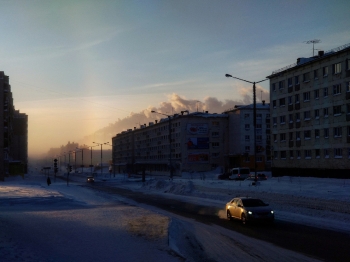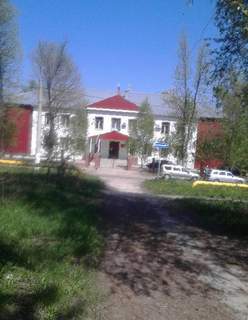Roman Popov: Contrary to the stereotype of the single -industry towards, people are not necessarily depressive in a long and cold pipe between the buildings of the Copper Plant. This is not a shift in workers, this is a show
Roman Popov: Contrary to the stereotype of the single -industry towns, they are not necessarily depressed

In a long and cold pipe between the buildings of the Copper Plant, people slowly go. This is not a red -hot workers, this is a show of young domestic designers from the Lumpen agency. As a models of Norilsk residents: a seller, laboratory assistant, a watchman, a factory worker, whom the organizers first saw on the Board of Honor. 40 models out of 300 people were personally selected by the founder of Lumpen Avdotya Alexandrov. So far, a dozen people with detached faces – some in a balaclava with fly agaric, some in a dress from a grid, some in a jacket for the polar winter – pace surrounded by corrugated board, one of those present quietly argues whether the model can determine the gender by appearance. This is how the first day of the city festival of fashion and contemporary art Black Coat takes place.
Everyone was taken from Moscow and would really like to leave here. Maybe try on? After showing in the abandoned pavilions of the former constructivist trade house, pop-ap-storas were located. There are few locals. “The whole essence of modern culture is integrated into another environment,” Alexandrova shares his impressions of the show. “This is the non -standard beauty of interaction with workers at the factory. We learned and experienced something – they learned and survived …” several models She takes from Norilsk to a show in Paris.
In the urban environment index, which was published in Russia at the end of 2019, Norilsk was among the best. Okay with high indicators of the quality of the urban environment in Moscow and St. Petersburg, but in Norilsk, how? It is quite a reasonable question, because the paradox is evident: how it happened that the quality of the urban environment of the Zapolyarny city of the fact, from which everyone leaves upon reaching a pension in more Favorable cities, in order not to kill at all and so shaken health, is higher than the cities in which people live quietly all their lives? – asks the urbanist and sociologist Peter Ivanov. That is how they usually judge Norilsk in the rest of Russia or, as it is customary to say, on the mainland.
Norilsk is the northern city of the world where more than 150 thousand people live. The climate here is extreme: strong wind, average temperature –27 in winter and +10 in summer, snow lies 8 months a year.
Sometimes the road to the airport is closed, where you can only get on shifts, and in schools they announce assets – the cancellation of classes due to bad weather, which can last for weeks. At the same time, it is indeed recognized as a city with a favorable urban environment, where housing and adjacent spaces, a street-road network, socio-business infrastructure and citywide spaces are highly appreciated. How did it happen?
Urbanist Andrei Elbaev notes that Norilsk looks like a city everywhere. The most valuable thing in the structure of the territory is compactness. In Norilsk, a suburban environment, that is, a private sector and sleeping microdistricts, is not at all, thanks to the layout of the city and the good density of development, he explains. – On the one hand, the index does not fix the most difficult parameter for Norilsk – air quality. On the other hand, compactness helps greatly, due to which the city is highly appreciated by the variety of functions, the availability of objects, the quality of the environment. This is a city where everything is at hand: if desired, you can only move here on foot, and any trip within the city will cost the city in 100 rubles.
Another component of the Black Coat festival – “Fox Hunt”. The artist Ksyusha listened to her signature icon on the buildings and invited residents to find them all. In the afternoon, Norilsk is yellow, Marsala, pink, blue and other inconsistent, but still appropriate against the background of snow (and in the middle of a polar night), shades in the color of the facades of the houses of the city center. Winter in the evenings, the windows of apartments turn into raspberry-neon squares-so, in conditions of lack of light, they try to preserve indoor plants.
Leningrad residents were responsible for the architectural and design part in the 1930s, so even the main street-Leninsky Prospekt-vaguely resembles Nevsky. You can go through arches, inside of which there are handrails in the courtyards. This specific urbanic element becomes necessary when a strong wind or black purge occurs. From the strong winds located on the street can blow out.
Everything that seems so excessive in Moscow is a festive street illumination, large multi -colored murals, bright facades of houses and even renovation – in Norilsk it becomes a necessary element of the urban environment. The buildings are arranged so that the wind, which reaches 30 meters per second, has nothing to catch on-the highest ends with the 12th floor. On some are the signs Caution, it is possible to collapse the facade. The state of the housing stock is one of the main problems of the city. Every tenth house needs reconstruction, and in the future for twenty years, about a third of all housing will come into a worthless state.
At the same time, you can find an almost unique example of working with the Soviet heritage here: last year, a series of Soviet mosaics depicting metallurgists, builders and astronauts was carefully restored on one of the streets. After the street art festival in the city, several facades with the northern deer, polar bears and a goal that score a football player from the artist Yegor Koshelev appeared.
Previously, panel houses in the conditions of permafrost were built on stilts: so that the heat from the house would not flood the foundation. Now outdated technologies have not disappeared, although modular construction and construction on grillages (an existing foundation) may be replaced.The renovation of the Zhilfond Norilsk will cost 85 billion rubles: half the costs are ready to take on the Norilskel enterprise, where half of the city’s inhabitants work.
The endless white open spaces of the tundra and the black silhouette in the frame, two women – one in an old -fashioned black hat, the other with a turquoise square – in the lobby of the old Soviet cinema. This is the show of the Black Coat: the director and director of the festival Olga Proskornina shot him according to the terrible fairy tale of Lyudmila Petrushevskaya. The city itself was the decoration for the film: the shooting took place in Norilsk.
Having for the first time in Norilsk in March 2017, I realized: I will shoot my film here-and, of course, only in the cold season. Then, of course, the whole team cursed me for not choosing some kind of any A cheerful summer story, the action of which takes place in the resort area. But the artistic truth is worth sacrificing household comfort. Norilsk and its surroundings are a ready -made living decoration for a mystical thriller, ”says Proskornina.
Mystical ice spaces, scattered in the snow, terrible iron skeletons of some mechanisms that have not been for the rests of ancient equipment, stuck forever, drowned in the ice desert – that which is nowhere else in the world. And I examined a small figure, which sorely crazy in deep snow – – not in a black coat, but in the same icy as everything around, the black case of a strange configuration. Almost in the coffin. Figure, reminding about the thousands of Stalinist prisoners who died here, about the prisoners who had nowhere to escape, but they moved through the thorny wire They wandered in the snow, breathed in this last freedom. And they remained in permafrost, ”Petrushevskaya writes his Norilsk Diary on Facebook.
Norillag was the most cruel branch of the entire camp of the camps. Since 1935, over 20 years, more than three hundred thousand prisoners have passed through it, including political zones according to the 58th counter-revolutionary article. The prisoners rebuilt the whole city. Today, with complex historical memory, the city is all right. If you overcome the endlessly stretching chain of wagons with ore, old production buildings and climb the Mount of Schmidtich, you can get to the Norilsk Calvary, the former Norillag cemetery, and now a memorial place in memory of the victims of political repressions. Norilsk is very carefully kept by this memory, with great respect and compassion and a sense of gratitude, because a lot of these people are built in Norilsk. We do not hide it, says Karina Andreeva from the Norilsk development agency.
Norilsk is a single -industry. Half of the inhabitants work at Norkel enterprises. There are mines here, a fire farm is produced at the metallurgical plant-an enriched ore, which diesel-electrodes (they also belong to Norilskel, the company has its own airline) is transported to Murmansk and Europe.
Monotowns are everywhere, but in Russia there are especially many of them (according to official data – about 320, according to expert estimates – at least a third more). In fact, every tenth person lives in a single-industry town. Despite this, single-industry towns are not alike, explains Roman Popov, an expert at the Institute of Urban Economics. The size, the profile of the main enterprise and the geographical location strongly influence: “After all, if the inhabitants of a small mining village, where the only mine was closed, can still be relocated to other settlements at the state expense, then what about the population of a city with a hundred thousandth population? Besides, a satellite of a large city is in a privileged position compared to an isolated single-industry town.
“Contrary to the stereotype, single-industry towns are not necessarily depressed and in crisis. If the city-forming company is economically successful today, cities can feel quite good. But potentially dependence is always a risk. An unfavorable change in market conditions will instantly bring down the welfare of the city,” says Popov .
The northern single-industry towns are ahead of the rest of Russia in all major economic parameters. Today, the average salary of employees of large and medium-sized enterprises in Norilsk is 93 thousand rubles. The city has an extreme level of investment per inhabitant – more than 421 thousand rubles per person.
However, in general, this situation does not meet the important principle of sustainability. “The sustainability of a single-industry city depends on the sustainability of the city-forming enterprise, and in northern cities it depends on the federal position regarding the support of a particular city. Therefore, for sustainability, it is necessary to reduce dependence on these factors by finding other reasons and opportunities for the existence of the city,” notes Andrey Elbaev. It is difficult to say what these reasons may be for Norilsk.
Last year, Time magazine ranked one among Russia's 100 most important photos: their natural habitat. And although the appearance of a bear on the streets is an exception, its existence depends on how the city solves the problem of ecology.
Now Norilsk is one of the cities with the most polluted air. The reason: emissions of pollutants into the atmosphere, in Norilsk this is sulfur dioxide, which is formed as a result of the metallurgical process. In a few years, Norilsk Nickel will have to take a difficult step to reduce its ecological footprint: emissions due to the restructuring of production should be reduced by 90% by 2025. The project cost exceeds $2.5 billion.
This is not the only challenge for the city. Climatologists promise that due to global warming by 2100 permafrost could thaw on average by 3-4 meters.Buildings may lose stability, and already in the 2040th the existence of many northern cities, including Norilsk, will be at risk. Eternal permafrost needs to be protected. The Arctic Scientific Research Center is monitoring and looking for engineering solutions that will allow you to save part of the development.
For three days, the Black Coat festival captured five city spaces. Artists turned the building of the former scientific and technical library into an installation Materialization of memory. The library is located in the most beautiful Stalin, in the city center, and after the festival will close to restoration: here they are going to open coworking and tourist-information center. Public spaces under the ceiling of a harsh urban environment are necessary.
In Norilsk and in such cities, where extremely extreme weather conditions, and even with harmful emissions into the atmosphere, the urban environment is essentially entertaining or cultural and entertainment centers. Of course, in the premises. After all, absurd weather can last for weeks and the tractor-the tractor. To cut the corridors for cars to drive, ”explains Julia Romanovskaya, chief architect of Umarchits, who designed a shopping and public center in Norilsk.
Does public spaces need a stern pole of a polar city? Urbanists assure that yes. You need to understand that a lot of people there work in industry and the budget sector, such places do not imply the possibility of remote work. Nevertheless, I think a certain number of third places will always be in demand for young people and hobbies outside working hours. Important. Important. The aspect of their existence is compactness, because such objects will be within walking distance of almost everyone where they are not accommodated, ”says Andrei Elbaev.
On the stage of the polar drama theater between banks with salted tomatoes, Julia Chebakova rolled Rosa Khairullina in a cart: two actresses talentedly and piercingly restored the play by Dmitry Brusnikin based on the play by Petrushevskaya “He in Argentina” and showed once in Norilsk.
“We all coincide in this admiration for Norilsk: both in front of the nature in which it is placed, and before his own mythology, which grows on this eternal permafrost,” says the director of the festival Olga Prokkornina. – At the same time, when you begin to listen to the Norilsk residents and what they say about your city, you see: this feeling of love for the place is often drowned out by the hardships of an extreme climate, irony about stereotypes about rich northerners and fear that everything can change. I really wanted to show Norilsk through the eyes of admiring observers, because the townspeople do not always have the opportunity in the routine of everyday life to see in what amazing place they live. The second part is expressed in a typical Norilian dichotomy: the mainland is us.Norilsk is an oasis in the middle of the tundra, preserved in its strange time: the end of the 80s, a little bit of the 90s and 00s. We wanted to show what was happening on the mainland in the meantime. It may be a little presumptuous to want to do so, but it was important for us to demonstrate what can be done in Norilsk using today's topical means of art.
For Norilsk city festivals are not supernatural. Last year, a gastrofestival, an ice fishing festival on the Yenisei, a winter ethnic festival Big Argish were held here with an ethnic camp built in the city and rituals of meeting the month of little darkness – November.
With tourism in Norilsk, everything is just beginning to take shape. Nearby is the Putorana Plateau with picturesque waterfalls and passes. In Taimyr, you can see how ethnic peoples live. Now the cost of a tour with helicopter transfer reaches 180 thousand rubles. Obviously, Norilsk cannot become Turkey, says the Norilsk Development Agency, which deals with the urban environment, tourism and business development, social and cultural projects and attracting investment. But Norilsk can take the place of the center of the Arctic: a meeting of mayors of northern cities from Japan, Korea, China, Mongolia, and Canada has already been held here.
Future
Can Norilsk be called a shift town? Yes and no. On the one hand, this is a city where people earn money and leave. There is a high level of migration here, the Norilsk people do not spend money in the city, preferring to save up for a vacation that lasts here until four months or even a future departure. The average resident of Norilsk is younger than the resident of another city (33 years versus 40), while people spend leisure time away from home twice as rarely as the national average.
Retirement age here comes earlier. Norilsk Nickel has special programs for the purchase of housing for employees in the Moscow and Tver regions, as well as in the Krasnodar Territory. In fact, at the age of 45-50, many begin a new life. Every year 12-14 thousand people leave the city. And so many are coming.
Over the past 10 years, the population in Norilsk has been stable, which indicates its position in the eyes of residents, so it is quite difficult to perceive it as a shift city. Yes, compared to other cities, Norilsk has a low population over working age, people retiring , in most cases they leave for the mainland, but this is a feature of all young cities in the country in regions with mining specialization. Norilsk is unique in nature, there are no such large cities in the world in terms of population in such a climate, therefore template stories do not suit it, says Evgenia Arefieva, managing partner of the Urbanica Institute.
The environment dictates its own characteristics of the development of the city. Last year, the Urbanika Institute developed a master plan for Norilsk based on unconventional solutions and successful examples from similar cities.For example, modular yards with a constant (lighting, car parking, utility areas and snow storage areas) and a variable part that can change from season to season. Among other recommendations – the development of public transport with warm stops and the arrangement of parking lots with personal electrical outlets for heating cars – now the engines are not turned off in cars, leaving them in the yards at night. Severe climatic conditions and the permafrost factor make Norilsk a testing ground for smart city technologies, they are proposed to be introduced into the building management system, transport systems, energy saving and waste collection. Some solutions that seem simple on the mainland are almost impossible to implement in Norilsk: for example, a waste recycling project can pay for itself only after 200 years. The recommendations of urbanists include a system of work with lighting and urban landscaping, which is now almost absent.
A city with a salary of almost 100 thousand rubles, with a polar night and a wind that takes people away. The city where they come to earn money for an apartment on the mainland, where they stay for another six months and stay for life. A city with terrible ecology and houses built on permafrost, but with schools and shops a step away from home, the polar theater and the inaccessible Putorana Plateau nearby, Norilsk lives in a different pace and dimension.
Modern urbanism, with its controlled compression, modular construction and focus on the comfort of urban life, would hardly approve of the emergence of new polar cities. “Maybe in the 21st century, cities in extreme climates are not needed at all? This opinion is not without reason. The development of technology makes it possible to extract resources remotely, so building new full-fledged cities in such conditions is really a controversial initiative,” says Andrey Elbaev. bases with a shift, where production control centers and all the necessary infrastructure will be located. Another thing is already existing cities with a rich history, with people who love these cities and consider them home. For such people, the answer to the question is obvious.







